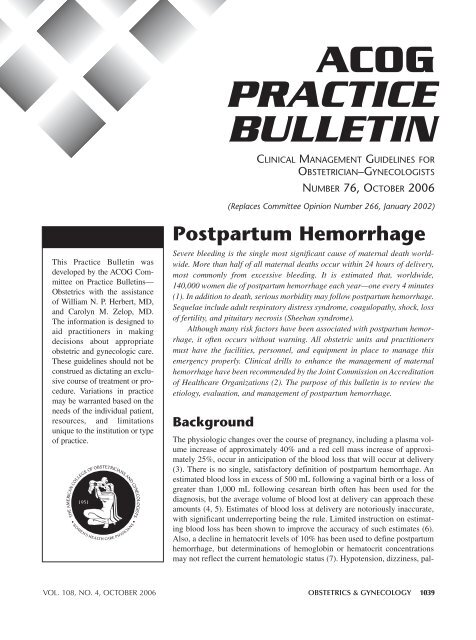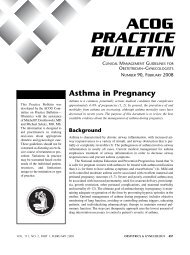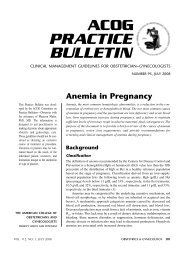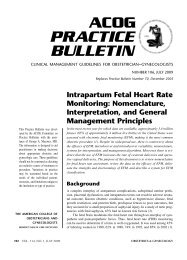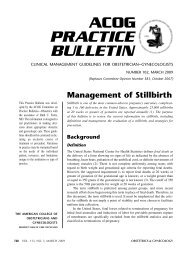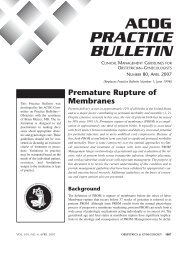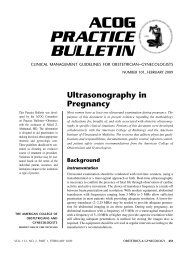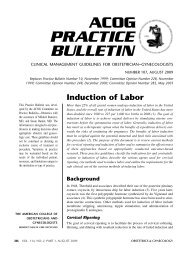ACOG Practice Bulletin No. 76: Postpartum Hemorrhage
ACOG Practice Bulletin No. 76: Postpartum Hemorrhage
ACOG Practice Bulletin No. 76: Postpartum Hemorrhage
Create successful ePaper yourself
Turn your PDF publications into a flip-book with our unique Google optimized e-Paper software.
<strong>ACOG</strong><br />
PRACTICE<br />
BULLETIN<br />
CLINICAL MANAGEMENT GUIDELINES FOR<br />
OBSTETRICIAN–GYNECOLOGISTS<br />
NUMBER <strong>76</strong>, OCTOBER 2006<br />
(Replaces Committee Opinion Number 266, January 2002)<br />
This <strong>Practice</strong> <strong>Bulletin</strong> was<br />
developed by the <strong>ACOG</strong> Committee<br />
on <strong>Practice</strong> <strong>Bulletin</strong>s—<br />
Obstetrics with the assistance<br />
of William N. P. Herbert, MD,<br />
and Carolyn M. Zelop, MD.<br />
The information is designed to<br />
aid practitioners in making<br />
decisions about appropriate<br />
obstetric and gynecologic care.<br />
These guidelines should not be<br />
construed as dictating an exclusive<br />
course of treatment or procedure.<br />
Variations in practice<br />
may be warranted based on the<br />
needs of the individual patient,<br />
resources, and limitations<br />
unique to the institution or type<br />
of practice.<br />
<strong>Postpartum</strong> <strong>Hemorrhage</strong><br />
Severe bleeding is the single most significant cause of maternal death worldwide.<br />
More than half of all maternal deaths occur within 24 hours of delivery,<br />
most commonly from excessive bleeding. It is estimated that, worldwide,<br />
140,000 women die of postpartum hemorrhage each year—one every 4 minutes<br />
(1). In addition to death, serious morbidity may follow postpartum hemorrhage.<br />
Sequelae include adult respiratory distress syndrome, coagulopathy, shock, loss<br />
of fertility, and pituitary necrosis (Sheehan syndrome).<br />
Although many risk factors have been associated with postpartum hemorrhage,<br />
it often occurs without warning. All obstetric units and practitioners<br />
must have the facilities, personnel, and equipment in place to manage this<br />
emergency properly. Clinical drills to enhance the management of maternal<br />
hemorrhage have been recommended by the Joint Commission on Accreditation<br />
of Healthcare Organizations (2). The purpose of this bulletin is to review the<br />
etiology, evaluation, and management of postpartum hemorrhage.<br />
Background<br />
The physiologic changes over the course of pregnancy, including a plasma volume<br />
increase of approximately 40% and a red cell mass increase of approximately<br />
25%, occur in anticipation of the blood loss that will occur at delivery<br />
(3). There is no single, satisfactory definition of postpartum hemorrhage. An<br />
estimated blood loss in excess of 500 mL following a vaginal birth or a loss of<br />
greater than 1,000 mL following cesarean birth often has been used for the<br />
diagnosis, but the average volume of blood lost at delivery can approach these<br />
amounts (4, 5). Estimates of blood loss at delivery are notoriously inaccurate,<br />
with significant underreporting being the rule. Limited instruction on estimating<br />
blood loss has been shown to improve the accuracy of such estimates (6).<br />
Also, a decline in hematocrit levels of 10% has been used to define postpartum<br />
hemorrhage, but determinations of hemoglobin or hematocrit concentrations<br />
may not reflect the current hematologic status (7). Hypotension, dizziness, pal-<br />
VOL. 108, NO. 4, OCTOBER 2006 OBSTETRICS & GYNECOLOGY 1039
▲<br />
lor, and oliguria do not occur until blood loss is substantial—10%<br />
or more of total blood volume (8).<br />
<strong>Postpartum</strong> hemorrhage generally is classified as<br />
primary or secondary, with primary hemorrhage occurring<br />
within the first 24 hours of delivery and secondary<br />
hemorrhage occurring between 24 hours and 6–12 weeks<br />
postpartum. Primary postpartum hemorrhage, which<br />
occurs in 4–6% of pregnancies, is caused by uterine<br />
atony in 80% or more of cases (7). Other etiologies are<br />
shown in the box “Etiology of <strong>Postpartum</strong> <strong>Hemorrhage</strong>,”<br />
with risk factors for excessive bleeding listed in the box<br />
“Risk Factors for <strong>Postpartum</strong> <strong>Hemorrhage</strong>.”<br />
If excessive blood loss is ongoing, concurrent evaluation<br />
and management are necessary. A number of general<br />
medical supportive measures may be instituted,<br />
including provision of ample intravenous access; crystalloid<br />
infusion; blood bank notification that blood products<br />
may be necessary; prompt communication with anesthesiology,<br />
nursing, and obstetrician–gynecologists; and<br />
blood collection for baseline laboratory determinations.<br />
When treating postpartum hemorrhage, it is necessary<br />
to balance the use of conservative management techniques<br />
with the need to control the bleeding and achieve<br />
hemostasis. A multidisciplinary approach often is<br />
required. In the decision-making process, less-invasive<br />
methods should be tried initially if possible, but if unsuccessful,<br />
preservation of life may require hysterectomy.<br />
Management of postpartum hemorrhage may vary greatly<br />
among patients, depending on etiology of the bleeding,<br />
available treatment options, and a patient’s desire for<br />
Etiology of <strong>Postpartum</strong> <strong>Hemorrhage</strong><br />
Primary<br />
Uterine atony<br />
Retained placenta—especially placenta accreta<br />
Defects in coagulation<br />
Uterine inversion<br />
Secondary<br />
Subinvolution of placental site<br />
Retained products of conception<br />
Infection<br />
Inherited coagulation defects<br />
Adapted from Cunningham FG, Leveno KJ, Bloom SL, Hauth JC,<br />
Gilstrap L 3rd, Wenstrom KD. Obstetric hemorrhage. In: Williams<br />
obstetrics. 22nd ed. New York (NY): McGraw-Hill; 2005. p. 809–54<br />
and Alexander J, Thomas P, Sanghera J. Treatments for secondary<br />
postpartum haemorrhage. The Cochrane Database of Systematic<br />
Reviews 2002, Issue 1. Art. <strong>No</strong>.: CD002867. DOI: 10.1002/<br />
14651858.CD002867.<br />
future fertility. At times, immediate surgery is required<br />
because time spent using other treatment methods would<br />
be dangerous for the patient. There are few randomized<br />
controlled studies relevant to the management of postpartum<br />
hemorrhage, so management decisions usually<br />
are made based on clinical judgment.<br />
Evaluation and Management<br />
Considerations<br />
In an effort to prevent uterine atony and associated bleeding,<br />
it is routine to administer oxytocin soon after delivery.<br />
This may be given at the time of delivery of the<br />
anterior shoulder of the fetus, or more commonly in the<br />
United States, following delivery of the placenta.<br />
It may be helpful to post protocols for hemorrhage<br />
management in delivery rooms or operating suites. A sample<br />
poster from the New York City Department of Health<br />
and Mental Hygiene is available at http://home2.nyc.gov/<br />
html/doh/downloads/pdf/ms/ms-hemorr-poster.pdf.<br />
Clinical Considerations and<br />
Recommendations<br />
What should be considered in the initial evaluation<br />
of a patient with excessive bleeding in<br />
the immediate puerperium<br />
Because the single most common cause of hemorrhage is<br />
uterine atony, the bladder should be emptied and a<br />
bimanual pelvic examination should be performed. The<br />
finding of the characteristic soft, poorly contracted<br />
(“boggy”) uterus suggests atony as a causative factor.<br />
Compression or massage of the uterine corpus can diminish<br />
bleeding, expel blood and clots, and allow time for<br />
other measures to be implemented.<br />
If bleeding persists, other etiologies besides atony<br />
must be considered. Even if atony is present, there may<br />
be other contributing factors. Lacerations should be ruled<br />
out by careful visual assessment of the lower genital<br />
tract. Proper patient positioning, adequate operative<br />
assistance, good lighting, appropriate instrumentation<br />
(eg, Simpson or Heaney retractors), and adequate anesthesia<br />
are necessary for the identification and proper<br />
repair of lacerations. Satisfactory repair may require<br />
transfer to a well-equipped operating room.<br />
Genital tract hematomas also can lead to significant<br />
blood loss. Progressive enlargement of the mass indicates<br />
a need for incision and drainage. Often a single bleeding<br />
source is not identified when a hematoma is incised.<br />
Draining the blood within the hematoma (sometimes<br />
1040 <strong>ACOG</strong> <strong>Practice</strong> <strong>Bulletin</strong> <strong>Postpartum</strong> <strong>Hemorrhage</strong> OBSTETRICS & GYNECOLOGY
▲<br />
Risk Factors for <strong>Postpartum</strong> <strong>Hemorrhage</strong><br />
Prolonged labor<br />
Augmented labor<br />
Rapid labor<br />
History of postpartum hemorrhage<br />
Episiotomy, especially mediolateral<br />
Preeclampsia<br />
Overdistended uterus (macrosomia, twins,<br />
hydramnios)<br />
Operative delivery<br />
Asian or Hispanic ethnicity<br />
Chorioamnionitis<br />
Data from Stones RW, Paterson CM, Saunders NJ. Risk factors for<br />
major obstetric haemorrhage. Eur J Obstet Gynecol Reprod Biol<br />
1993;48:15–8 and Combs CA, Murphy EL, Laros RK. Factors associated<br />
with hemorrhage in cesarean deliveries. Obstet Gynecol<br />
1991;77:77–82.<br />
placing a drain in situ), suturing the incision, and if<br />
appropriate, packing the vagina are measures usually<br />
successful in achieving hemostasis. Interventional radiology<br />
is another option for management of a hematoma.<br />
Genital tract hematomas may not be recognized until<br />
hours after the delivery, and they sometimes occur in the<br />
absence of vaginal or perineal lacerations. The main<br />
symptoms are pelvic or rectal pressure and pain.<br />
The possibility that additional products of conception<br />
remain within the uterine cavity should be considered.<br />
Ultrasonography can help diagnose a retained<br />
placenta. Retained placental tissue is unlikely when<br />
ultrasonography reveals a normal endometrial stripe.<br />
Although ultrasonographic images of retained placental<br />
tissue are inconsistent, detection of an echogenic mass in<br />
the uterus is more conclusive. Ultrasound evaluation for<br />
retained tissue should be performed before uterine<br />
instrumentation is undertaken (9). Spontaneous expulsion<br />
of the placenta, apparent structural integrity on<br />
inspection, and the lack of a history of previous uterine<br />
surgery (suggesting an increased risk of abnormal placentation)<br />
make a diagnosis of retained products of the<br />
placenta less likely, but a curettage may identify a succenturiate<br />
lobe of the placenta or additional placental tissue.<br />
When a retained placenta is identified, a large, blunt<br />
instrument, such as a banjo curette or ring forceps, guided<br />
by ultrasonography, makes removal of the retained<br />
tissue easier and reduces the risk of perforation.<br />
Less commonly, postpartum hemorrhage may be<br />
caused by coagulopathy. Clotting abnormalities should<br />
be suspected on the basis of patient or family history<br />
or clinical circumstances. Hemolysis, elevated liver<br />
enzymes, and low platelet count (HELLP) syndrome,<br />
abruptio placentae, prolonged intrauterine fetal demise,<br />
sepsis, and amniotic fluid embolism are associated with<br />
clotting abnormalities. Significant hemorrhage from any<br />
cause can lead to consumption of clotting factors.<br />
Observation of the clotting status of blood recently lost<br />
can provide important information. When a coagulopathy<br />
is suspected, appropriate testing should be ordered,<br />
with blood products infused as indicated. In some situations,<br />
the coagulopathy may be caused or perpetuated by<br />
the hemorrhage. In such cases, simultaneous surgery and<br />
blood product replacement may be necessary.<br />
Baseline studies should be ordered when excessive<br />
blood loss is suspected and should be repeated periodically<br />
as clinical circumstances warrant. Clinicians<br />
should remember that the results of some studies may be<br />
misleading because equilibration may not have occurred.<br />
In addition, response to hemorrhage may be required<br />
before laboratory results are known. Baseline studies<br />
include a complete blood count with platelets, a prothrombin<br />
time, an activated partial thromboplastin time,<br />
fibrinogen, and a type and cross order. The blood bank<br />
should be notified that transfusion may be necessary.<br />
The clot observation test provides a simple measure<br />
of fibrinogen (10). A volume of 5 mL of the patient’s<br />
blood is placed into a clean, red-topped tube and<br />
observed frequently. <strong>No</strong>rmally, blood will clot within<br />
8–10 minutes and will remain intact. If the fibrinogen<br />
concentration is low, generally less than 150 mg/dL, the<br />
blood in the tube will not clot, or if it does, it will undergo<br />
partial or complete dissolution in 30–60 minutes.<br />
What is the appropriate medical management<br />
approach for excessive postpartum bleeding<br />
Ongoing blood loss in the setting of decreased uterine<br />
tone requires the administration of additional uterotonics<br />
as the first-line treatment for hemorrhage (Table 1).<br />
Some practitioners prefer direct injection of methylergonovine<br />
maleate and 15-methyl prostaglandin (PG) F 2α<br />
into the uterine corpus. Human recombinant factor VIIa<br />
is a new treatment modality shown to be effective in<br />
controlling severe, life-threatening hemorrhage by acting<br />
on the extrinsic clotting pathway. Intravenous dosages<br />
vary by case and generally range from 50 to 100 mcg/kg<br />
every 2 hours until hemostasis is achieved. Cessation of<br />
bleeding ranges from 10 minutes to 40 minutes after<br />
administration (11–14). Concern has been raised because<br />
of apparent risk of subsequent thromboembolic<br />
events following factor VIIa use (15). Compared with<br />
other agents, factor VIIa is extremely expensive.<br />
Additional clinical experience in all specialties will help<br />
VOL. 108, NO. 4, OCTOBER 2006 <strong>ACOG</strong> <strong>Practice</strong> <strong>Bulletin</strong> <strong>Postpartum</strong> <strong>Hemorrhage</strong> 1041
Table 1. Medical Management of <strong>Postpartum</strong> <strong>Hemorrhage</strong><br />
Drug* Dose/Route Frequency Comment<br />
Oxytocin (Pitocin) IV: 10–40 units in 1 liter Continuous Avoid undiluted rapid IV infusion,<br />
normal saline or lactated<br />
which causes hypotension.<br />
Ringer’s solution<br />
IM: 10 units<br />
Methylergonovine IM: 0.2 mg Every 2–4 h Avoid if patient is hypertensive.<br />
(Methergine)<br />
15-methyl PGF 2α<br />
IM: 0.25 mg Every 15–90 min, Avoid in asthmatic patients;<br />
(Carboprost) 8 doses maximum relative contraindication if<br />
(Hemabate)<br />
hepatic, renal, and cardiac<br />
disease. Diarrhea, fever,<br />
tachycardia can occur.<br />
Dinoprostone Suppository: vaginal Every 2 h Avoid if patient is hypotensive.<br />
(Prostin E 2<br />
) or rectal Fever is common. Stored frozen,<br />
20 mg it must be thawed to room<br />
temperature.<br />
Misoprostol<br />
800–1,000 mcg rectally<br />
(Cytotec, PGE 1<br />
)<br />
Abbreviations: IV, intravenously; IM, intramuscularly; PG, prostaglandin.<br />
*All agents can cause nausea and vomiting.<br />
Modified from Dildy GA, Clark SL. <strong>Postpartum</strong> hemorrhage. Contemp Ob/Gyn 1993;38(8):21–9.<br />
determine factor VIIa’s role in the treatment of patients<br />
with postpartum hemorrhage.<br />
▲ ▲<br />
When is packing or tamponade of the uterine<br />
cavity advisable<br />
When uterotonics fail to cause sustained uterine contractions<br />
and satisfactory control of hemorrhage after vaginal<br />
delivery, tamponade of the uterus can be effective in<br />
decreasing hemorrhage secondary to uterine atony (Table<br />
2). Such approaches can be particularly useful as a temporizing<br />
measure, but if a prompt response is not seen,<br />
preparations should be made for exploratory laparotomy.<br />
Packing with gauze requires careful layering of the<br />
material back and forth from one cornu to the other using<br />
a sponge stick, packing back and forth, and ending with<br />
extension of the gauze through the cervical os. The same<br />
effect often can be derived more easily using a Foley<br />
catheter, Sengstaken-Blakemore tube, or, more recently,<br />
the SOS Bakri tamponade balloon (16), specifically tailored<br />
for tamponade within the uterine cavity in cases of<br />
postpartum hemorrhage secondary to uterine atony.<br />
When are surgical techniques used to control<br />
uterine bleeding<br />
When uterotonic agents with or without tamponade<br />
measures fail to control bleeding in a patient who has<br />
given birth vaginally, exploratory laparotomy is indicated.<br />
A midline vertical abdominal incision usually is preferred<br />
to optimize exposure. Several techniques are<br />
available to control bleeding (Table 3). Hypogastric<br />
artery ligation is performed much less frequently than in<br />
years past. Its purpose is to diminish the pulse pressure of<br />
blood flowing to the uterus via the internal iliac<br />
(hypogastric) vessels. Practitioners are less familiar with<br />
this technique, and the procedure has been found to be<br />
considerably less successful than previously thought<br />
(17). Bilateral uterine artery ligation (O’Leary sutures)<br />
accomplishes the same goal, and this procedure is quicker<br />
and easier to perform (18, 19). To further diminish<br />
blood flow to the uterus, similar sutures can be placed<br />
across the vessels within the uteroovarian ligaments.<br />
The B-Lynch technique is a newer procedure for<br />
stopping excessive bleeding caused by uterine atony (20).<br />
The suture provides even pressure to compress the uterine<br />
corpus and decrease bleeding. One study reported more<br />
Table 2. Tamponade Techniques for <strong>Postpartum</strong> <strong>Hemorrhage</strong><br />
Technique<br />
Uterine tamponade<br />
—Packing<br />
—Foley catheter<br />
—Sengstaken–Blakemore tube<br />
—SOS Bakri tamponade balloon<br />
Comment<br />
—4-inch gauze; can soak with<br />
5,000 units of thrombin in 5 mL<br />
of sterile saline<br />
—Insert one or more bulbs; instill<br />
60–80 mL of saline<br />
—Insert balloon; instill 300–500 mL<br />
of saline<br />
1042 <strong>ACOG</strong> <strong>Practice</strong> <strong>Bulletin</strong> <strong>Postpartum</strong> <strong>Hemorrhage</strong> OBSTETRICS & GYNECOLOGY
▲<br />
Table 3. Surgical Management of <strong>Postpartum</strong> <strong>Hemorrhage</strong><br />
Technique<br />
Uterine curettage<br />
Uterine artery ligation<br />
B-Lynch suture<br />
Hypogastric artery ligation<br />
Repair of rupture<br />
Hysterectomy<br />
Comment<br />
Bilateral; also can ligate uteroovarian<br />
vessels<br />
Less successful than earlier thought;<br />
difficult technique; generally<br />
reserved for practitioners<br />
experienced in the procedure<br />
than 1,000 B-Lynch procedures with only seven failures<br />
(21). However, because the technique is new, many clinicians<br />
have limited experience with this procedure (22).<br />
Hemostatic multiple square suturing is another new<br />
surgical technique for postpartum hemorrhage caused by<br />
uterine atony, placenta previa, or placenta accreta. The<br />
procedure eliminates space in the uterine cavity by suturing<br />
both anterior and posterior uterine walls. One study<br />
reported on this technique in 23 women after conservative<br />
treatment failed. All patients were examined after 2<br />
months, and ultrasound findings confirmed normal<br />
endometrial linings and uterine cavities (23).<br />
What are the clinical considerations for<br />
suspected placenta accreta<br />
Abnormal attachment of the placenta to the inner uterine<br />
wall (placenta accreta) can cause massive hemorrhage. In<br />
fact, accreta and uterine atony are the two most common<br />
reasons for postpartum hysterectomy (24, 25). Risk factors<br />
for placenta accreta include placenta previa with or without<br />
previous uterine surgery, prior myomectomy, prior<br />
cesarean delivery, Asherman’s syndrome, submucous<br />
leiomyomata, and maternal age older than 35 years (26).<br />
Prior cesarean delivery and the presence of placenta<br />
previa in a current pregnancy are particularly important risk<br />
factors for placenta accreta. In a multicenter study of more<br />
than 30,000 patients who had cesarean delivery without<br />
labor, the risk of placenta accreta was approximately 0.2%,<br />
0.3%, 0.6%, 2.1%, 2.3%, and 7.7% for women experiencing<br />
their first through sixth cesarean deliveries, respectively.<br />
In patients with placenta previa in the current pregnancy,<br />
the risk of accreta was 3%, 11%, 40%, 61%, and 67% for<br />
those undergoing their first through their fifth or greater<br />
cesarean deliveries, respectively (27).<br />
Women with placenta previa or placenta accreta<br />
have a higher incidence of postpartum hemorrhage and<br />
are more likely to undergo emergency hysterectomy<br />
(28). In the multicenter study cited previously, hysterectomy<br />
was required in 0.7% for the first cesarean delivery<br />
and increased with each cesarean delivery up to 9% for<br />
patients with their sixth or greater cesarean delivery.<br />
In the presence of previa or a history of cesarean<br />
delivery, the obstetric care provider must have a high<br />
clinical suspicion for placenta accreta and take appropriate<br />
precautions. Ultrasonography may be helpful in<br />
establishing the diagnosis in the antepartum period.<br />
Color Doppler technology may be an additional adjunctive<br />
tool for suspected accreta (29). Despite advances in<br />
imaging techniques, no diagnostic technique affords the<br />
clinician complete assurance of the presence or absence<br />
of placenta accreta.<br />
If the diagnosis or a strong suspicion is formed<br />
before delivery, a number of measures should be taken:<br />
• The patient should be counseled about the likelihood<br />
of hysterectomy and blood transfusion.<br />
• Blood products and clotting factors should be available.<br />
• Cell saver technology should be considered if available.<br />
• The appropriate location and timing for delivery<br />
should be considered to allow access to adequate<br />
surgical personnel and equipment.<br />
• A preoperative anesthesia assessment should beobtained.<br />
The extent (area, depth) of the abnormal attachment<br />
will determine the response—curettage, wedge resection,<br />
medical management, or hysterectomy. Uterine conserving<br />
options may work in small focal accretas, but abdominal<br />
hysterectomy usually is the most definitive treatment.<br />
▲ ▲<br />
Under what circumstances is arterial<br />
embolization indicated<br />
A patient with stable vital signs and persistent bleeding,<br />
especially if the rate of loss is not excessive, may be a candidate<br />
for arterial embolization. Radiographic identification<br />
of bleeding vessels allows embolization with Gelfoam,<br />
coils, or glue. Balloon occlusion is also a technique used in<br />
such circumstances. Embolization can be used for bleeding<br />
that continues after hysterectomy or can be used as an<br />
alternative to hysterectomy to preserve fertility.<br />
When is blood transfusion recommended<br />
Is there a role for autologous transfusions<br />
or directed donor programs<br />
Transfusion of blood products is necessary when the<br />
extent of blood loss is significant and ongoing, particularly<br />
if vital signs are unstable. <strong>Postpartum</strong> transfusion<br />
VOL. 108, NO. 4, OCTOBER 2006 <strong>ACOG</strong> <strong>Practice</strong> <strong>Bulletin</strong> <strong>Postpartum</strong> <strong>Hemorrhage</strong> 1043
▲<br />
▲<br />
rates vary between 0.4% and 1.6% (30). Clinical judgment<br />
is an important determinant, given that estimates of<br />
blood loss often are inaccurate, determination of hematocrit<br />
or hemoglobin concentrations may not accurately<br />
reflect the current hematologic status, and symptoms and<br />
signs of hemorrhage may not occur until blood loss<br />
exceeds 15% (8). The purpose of transfusion of blood<br />
products is to replace coagulation factors and red cells for<br />
oxygen-carrying capacity, not for volume replacement.<br />
To avoid dilutional coagulopathy, concurrent replacement<br />
with coagulation factors and platelets may be necessary.<br />
Table 4 lists blood components, indications for<br />
transfusion, and hematologic effects.<br />
Autologous transfusion (donation, storage, retransfusion)<br />
has been shown to be safe in pregnancy (31, 32).<br />
However, it requires anticipation of the need for transfusion,<br />
as well as a minimal hematocrit concentration often<br />
above that of a pregnant woman. Autologous transfusion<br />
generally is reserved for situations with a high chance of<br />
transfusion in a patient with rare antibodies, where the<br />
likelihood of identifying compatible volunteer-provided<br />
blood is very low. Blood donated by directed donors has<br />
not been shown to be safer than blood from unknown,<br />
volunteer donors. Cell saver technology has been used<br />
successfully in patients undergoing cesarean delivery. In<br />
a multicenter study of 139 patients using such devices, no<br />
untoward outcomes were noted when compared with<br />
control patients (33).<br />
What is the management approach for<br />
hemorrhage due to a ruptured uterus<br />
Rupture can occur at the site of a previous cesarean delivery<br />
or other surgical procedure involving the uterine wall<br />
from intrauterine manipulation or trauma or from congenital<br />
malformation (small uterine horn), or it can occur<br />
spontaneously. Abnormal labor, operative delivery, and<br />
placenta accreta can lead to rupture. Surgical repair is<br />
required, with the specific approach tailored to reconstruct<br />
the uterus, if possible. Care depends on the extent<br />
and site of rupture, the patient’s current clinical condition,<br />
and her desire for future childbearing. Rupture of a<br />
previous cesarean delivery scar often can be managed by<br />
revision of the edges of the prior incision followed by<br />
primary closure. In addition to the myometrial disruption,<br />
consideration must be given to neighboring structures,<br />
such as the broad ligament, parametrial vessels,<br />
ureters, and bladder. Regardless of the patient’s wishes<br />
for the avoidance of hysterectomy, this procedure may<br />
be necessary in a life-threatening situation.<br />
What is the management approach for an<br />
inverted uterus<br />
Uterine inversion, in which the uterine corpus descends<br />
to, and sometimes through, the uterine cervix, is associated<br />
with marked hemorrhage. On bimanual examination,<br />
the finding of a firm mass below or near the cervix,<br />
coupled with the absence of identification of the uterine<br />
corpus on abdominal examination, suggests inversion.<br />
If the inversion occurs before placental separation,<br />
detachment or removal of the placenta should not be<br />
undertaken; this will lead to additional hemorrhage.<br />
Replacement of the uterine corpus involves placing the<br />
palm of the hand against the fundus (now inverted and<br />
lowermost at or through the cervix), as if holding a tennis<br />
ball, with the fingertips exerting upward pressure<br />
circumferentially (34). To restore normal anatomy, relaxation<br />
of the uterus may be necessary. Terbutaline,<br />
magnesium sulfate, halogenated general anesthetics, and<br />
nitroglycerin have been used for uterine relaxation.<br />
Manual replacement with or without uterine relaxants<br />
usually is successful. In the unusual circumstance in<br />
which it is not, laparotomy is required. Two procedures<br />
have been reported to return the uterine corpus to the<br />
abdominal cavity. The Huntington procedure involves<br />
Table 4. Blood Component Therapy<br />
Product Volume (mL) Contents Effect (per unit)<br />
Packed red cells 240 Red blood cells, Increase hematocrit 3 percentage<br />
white blood cells, plasma points, hemoglobin by 1 g/dL<br />
Platelets 50 Platelets, red blood cells, Increase platelet count 5,000–<br />
white blood cells, plasma 10,000/mm 3 per unit<br />
Fresh frozen plasma 250 Fibrinogen, antithrombin III, Increase fibrinogen by 10 mg/dL<br />
factors V and VIII<br />
Cryoprecipitate 40 Fibrinogen, factors VIII and Increase fibrinogen by 10 mg/dL<br />
XIII, von Willebrand factor<br />
Modified from Martin SR, Strong TH Jr. Transfusion of blood components and derivatives in the obstetric intensive care<br />
patient. In: Foley MR, Strong TH Jr, Garite TJ, editors. Obstetric intensive care manual. 2nd ed. New York (NY): McGraw-Hill;<br />
2004. Produced with permission of The McGraw-Hill Companies.<br />
1044 <strong>ACOG</strong> <strong>Practice</strong> <strong>Bulletin</strong> <strong>Postpartum</strong> <strong>Hemorrhage</strong> OBSTETRICS & GYNECOLOGY
▲<br />
▲ ▲ ▲ ▲<br />
▲<br />
progressive upward traction on the inverted corpus using<br />
Babcock or Allis forceps (35). The Haultain procedure<br />
involves incising the cervical ring posteriorly, allowing<br />
for digital repositioning of the inverted corpus, with subsequent<br />
repair of the incision (36).<br />
What is the management approach for<br />
secondary postpartum hemorrhage<br />
Secondary hemorrhage occurs in approximately 1% of<br />
pregnancies; often the specific etiology is unknown.<br />
<strong>Postpartum</strong> hemorrhage may be the first indication for<br />
von Willebrand’s disease for many patients and should<br />
be considered. The prevalence of von Willebrand’s disease<br />
is reported to be 10–20% among adult women with<br />
menorrhagia (37). Hence, testing for bleeding disorders<br />
should be considered among pregnant patients with a<br />
history of menorrhagia because the risk of delayed or<br />
secondary postpartum hemorrhage is high among<br />
women with bleeding disorders (38, 39).<br />
Uterine atony (perhaps secondary to retained products<br />
of conception) with or without infection contributes<br />
to secondary hemorrhage. The extent of bleeding<br />
usually is less than that seen with primary postpartum<br />
hemorrhage. Ultrasound evaluation can help identify<br />
intrauterine tissue or subinvolution of the placental site.<br />
Treatment may include uterotonic agents, antibiotics,<br />
and curettage. Often the volume of tissue removed by<br />
curettage is minimal, yet bleeding subsides promptly.<br />
Care must be taken in performing the procedure to avoid<br />
perforation of the uterus. Concurrent ultrasound assessment<br />
at the time of curettage can be helpful in preventing<br />
this complication. Patients should be counseled<br />
about the possibility of hysterectomy before initiating<br />
any operative procedures.<br />
What is the best approach to managing<br />
excessive blood loss in the postpartum period<br />
once the patient’s condition is stable<br />
Regardless of the cause of postpartum hemorrhage, subsequent<br />
replacement of the red cell mass is important.<br />
Along with a prenatal vitamin and mineral capsule daily<br />
(which contains about 60 mg of elemental iron and<br />
1 mg folate), two additional iron tablets (ferrous sulfate,<br />
300 mg, each yielding about 60 mg of elemental iron) will<br />
maximize red cell production and restoration. Erythropoietin<br />
can hasten red cell production in postpartum anemic<br />
patients to some extent, but it is not approved by the<br />
U.S. Food and Drug Administration for postoperative anemia,<br />
and it can be costly (40). <strong>Postpartum</strong> hemorrhage in<br />
a subsequent pregnancy occurs in approximately 10% of<br />
patients (8).<br />
Summary of<br />
Recommendations and<br />
Conclusions<br />
The following recommendations and conclusions<br />
are based primarily on consensus and expert opinion<br />
(Level C):<br />
Uterotonic agents should be the first-line treatment<br />
for postpartum hemorrhage due to uterine atony.<br />
Management may vary greatly among patients,<br />
depending on etiology and available treatment<br />
options, and often a multidisciplinary approach is<br />
required.<br />
When uterotonics fail following vaginal delivery,<br />
exploratory laparotomy is the next step.<br />
In the presence of conditions known to be associated<br />
with placenta accreta, the obstetric care provider<br />
must have a high clinical suspicion and take appropriate<br />
precautions.<br />
Proposed Performance<br />
Measure<br />
If hysterectomy is performed for uterine atony, there<br />
should be documentation of other therapy attempts.<br />
References<br />
1. AbouZahr C. Global burden of maternal death and disability.<br />
Br Med Bull 2003;67:1–11. (Level III)<br />
2. Preventing infant death and injury during delivery.<br />
Sentinel Event ALERT <strong>No</strong>. 30. Joint Commission on<br />
Accreditation of Healthcare Organizations. Available at:<br />
http://www.jointcommission.org/SentinelEvents/Sentinel<br />
EventAlert/sea_30.htm. Retrieved June 12, 2006. (Level<br />
III)<br />
3. Chesley LC. Plasma and red cell volumes during pregnancy.<br />
Am J Obstet Gynecol 1972;112:440–50. (Level III)<br />
4. Pritchard JA, Baldwin RM, Dickey JC, Wiggins KM.<br />
Blood volume changes in pregnancy and the puerperium.<br />
Am J Obstet Gyencol 1962;84:1271–82. (Level III)<br />
5. Clark SL, Yeh SY, Phelan JP, Bruce S, Paul RH.<br />
Emergency hysterectomy for obstetric hemorrhage.<br />
Obstet Gynecol 1984;64:3<strong>76</strong>–80. (Level III)<br />
6. Dildy GA 3, Paine AR, George NC, Velasco C. Estimating<br />
blood loss: can teaching significantly improve visual estimation<br />
Obstet Gynecol 2004;104:601–6. (Level III)<br />
7. Combs CA, Murphy EL, Laros RK Jr. Factors associated<br />
with postpartum hemorrhage with vaginal birth. Obstet<br />
Gynecol 1991;77:69–<strong>76</strong>. (Level II-2)<br />
VOL. 108, NO. 4, OCTOBER 2006 <strong>ACOG</strong> <strong>Practice</strong> <strong>Bulletin</strong> <strong>Postpartum</strong> <strong>Hemorrhage</strong> 1045
8. Bonnar J. Massive obstetric haemorrhage. Baillieres Best<br />
Pract Res Clin Obstet Gynaecol 2000;14:1–18. (Level III)<br />
9. Hertzberg BS, Bowie JD. Ultrasound of the postpartum<br />
uterus. Prediction of retained placental tissue. J Ultrasound<br />
Med 1991;10:451–6. (Level III)<br />
10. Poe MF. Clot observation test for clinical diagnosis of clotting<br />
defects. Anesthesiology 1959;20:825–9. (Level III)<br />
11. Bouwmeester FW, Jonkhoff AR, Verheijen RH, van Geijn<br />
HP. Successful treatment of life-threatening postpartum<br />
hemorrhage with recombinant activated factor VII. Obstet<br />
Gynecol 2003;101:1174–6. (Level III)<br />
12. Tanchev S, Platikanov V, Karadimov D. Administration of<br />
recombinant factor VIIa for the management of massive<br />
bleeding due to uterine atonia in the post-placental period.<br />
Acta Obstet Gynecol Scand 2005;84:402–3. (Level III)<br />
13. Boehlen F, Morales MA, Fontaana P, Ricou B, Irion O, de<br />
Moerloose P. Prolonged treatment of massive postpartum<br />
haemorrhage with recombinant factor VIIa: case report<br />
and review of the literature. BJOG 2004;111:284–7.<br />
(Level III)<br />
14. Segal S, Shemesh IY, Blumental R, Yoffe B, Laufer N,<br />
Mankuta D, et al. The use of recombinant factor VIIa in<br />
severe postpartum hemorrhage. Acta Obstet Gynecol<br />
Scand 2004;83:771–2. (Level III)<br />
15. O’Connell KA, Wood JJ, Wise RP, Lozier JN, Braun MM.<br />
Thromboembolic adverse events after use of recombinant<br />
human coagulation factor VIIa. JAMA 2006;295:293–8.<br />
(Level III)<br />
16. Bakri YN, Amri A, Abdul Jabbar F. Tamponade-balloon<br />
for obstetrical bleeding. Int J Gynaecol Obstet 2001;74:<br />
139–42. (Level III)<br />
17. Clark AL, Phelan JP, Yeh SY, Bruce SR, Paul RH.<br />
Hypogastric artery ligation for obstetric hemorrhage.<br />
Obstet Gynecol 1985:66:353–6. (Level III)<br />
18. O’Leary JL, O’Leary JA. Uterine artery ligation in the<br />
control of intractable postpartum hemorrhage. Am J<br />
Obstet Gynecol 1966;94:920–4. (Level III)<br />
19. O’Leary JL, O’Leary JA. Uterine artery ligation for control<br />
of postcesarean section hemorrhage. Obstet Gynecol<br />
1974;43:849–53. (Level III)<br />
20. B-Lynch C, Coker A, Lawal AH, Abu J, Cowen MJ. The<br />
B-Lynch surgical technique for the control of massive<br />
postpartum haemorrhage: an alternative to hysterectomy<br />
Five cases reported. Br J Obstet Gynaecol 1997;104:<br />
372–5. (Level III)<br />
21. Allam MS, B-Lynch C. The B-Lynch and other uterine<br />
compression suture techniques. Int J Gynaecol Obstet<br />
2005;89:236–41. (Level III)<br />
22. Holtsema H, Nijland R, Huisman A, Dony J, van den Berg<br />
PP. The B-Lynch technique for postpartum haemorrhage:<br />
an option for every gynaecologist. Eur J Obstet Gynecol<br />
Reprod Biol 2004;115:39–42. (Level III)<br />
23. Cho JH, Jun HS, Lee CN. Hemostatic suturing technique<br />
for uterine bleeding during cesarean delivery. Obstet<br />
Gynecol 2000;96:129–31. (Level III)<br />
24. Zelop CM, Harlow BL, Frigoletto FD, Safon LE,<br />
Saltzman DH. Emergency peripartum hysterectomy. Am<br />
J Obstet Gynecol 1993;168:1443–8. (Level II-3)<br />
25. Stanco LM, Schrimmer DB, Paul RH, Mishell DR Jr.<br />
Emergency peripartum hysterectomy and associated risk<br />
factors. Am J Obstet Gynecol 1993;168:879–83. (Level<br />
II-3)<br />
26. Clark SL, Koonings PP, Phelan JP. Placenta previa/<br />
accreta and prior cesarean section. Obstet Gynecol<br />
1985;66:89–92. (Level III)<br />
27. Silver RM, Landon MB, Rouse DT, Leveno KJ, Song CY,<br />
Thom EA, et al. Maternal morbidity associated with multiple<br />
repeat cesarean delivery. Obstet Gynecol 2006;107:<br />
1226–32. (Level II-2)<br />
28. Zaki ZM, Bahar AM, Ali ME, Albar HA, Gerais MA. Risk<br />
factors and morbidity in patients with placenta previa accreta<br />
compared to placenta previa non-accreta. Acta<br />
Obstet Gynecol Scand 1998;77:391–4. (Level II-3)<br />
29. Kirkinen P, Helin-Martikainen HL, Vanninen R, Partanen<br />
K. Placenta accreta: imaging by gray-scale and contrastenhanced<br />
color Doppler sonography and magnetic resonance<br />
imaging. J Clin Ultrasound 1998;26:90–4. (Level III)<br />
30. Petersen LA, Lindner DS, Kleiber CM, Zimmerman MB,<br />
Hinton AT, Yankowitz J. Factors that predict low hematocrit<br />
levels in the postpartum patient after vaginal delivery.<br />
Am J Obstet Gynecol 2002;186:737–4. (Level II-2)<br />
31. Kruskall MS, Leonard S, Klapholz H. Autologous blood<br />
donation during pregnancy: analysis of safety and blood<br />
use. Obstet Gynecol 1987;70:938–41. (Level III)<br />
32. Herbert WN, Owen HG, Collins ML. Autologous blood<br />
storage in obstetrics. Obstet Gynecol 1988;72:166–70.<br />
(Level III)<br />
33. Rebarber A, Lonser R, Jackson S, Copel JA, Sipes S. The<br />
safety of intraoperative autologous blood collection and<br />
autotransfusion during cesarean section. Am J Obstet<br />
Gynecol 1998;179:715–20. (Level II-2)<br />
34. Johnson AB. A new concept in the replacement of the<br />
inverted uterus and a report of nine cases. Am J Obstet<br />
Gynecol 1949;57:557–62. (Level III)<br />
35. Huntington JL, Irving FC, Kellogg FS. Abdominal reposition<br />
in acute inversion of the puerperal uterus. Am J<br />
Obstet Gynecol 1928;15:34–40. (Level III)<br />
36. Haultain FW. The treatment of chronic uterine inversion<br />
by abdominal hysterotomy, with a successful case. Br<br />
Med J 1901;2:974–6. (Level III)<br />
37. Demers C, Derzko C, David M, Douglas J. Gynaecological<br />
and obstetric management of women with inherited<br />
bleeding disorders. Society of Obstetricians and Gynecologists<br />
of Canada. J Obstet Gynaecol Can 2005;27:<br />
707–32. (Level III)<br />
38. Kadir RA, Aledort LM. Obstetrical and gynaecological<br />
bleeding: a common presenting symptom. Clin Lab<br />
Haematol 2000 Oct;22 suppl 1:12–6; discussion 30–2.<br />
(Level III)<br />
39. James AH. Von Willebrand disease. Obstet Gynecol Surv<br />
2006;61:136–45. (Level III)<br />
40. Kotto-Kome AC, Calhoun DA, Montenegro R, Sosa R,<br />
Maldonado L, Christensen RD. Effect of administering<br />
recombinant erythropoietin to women with postpartum<br />
anemia: a meta-analysis. J Perinatol 2004;24:11–5.<br />
(Meta-analysis)<br />
1046 <strong>ACOG</strong> <strong>Practice</strong> <strong>Bulletin</strong> <strong>Postpartum</strong> <strong>Hemorrhage</strong> OBSTETRICS & GYNECOLOGY
The MEDLINE database, the Cochrane Library, and the<br />
American College of Obstetricians and Gynecologists’ own<br />
internal resources and documents were used to conduct a<br />
literature search to locate relevant articles published between<br />
January 1901 and June 2006. The search was restricted<br />
to articles published in the English language.<br />
Priority was given to articles reporting results of original<br />
research, although review articles and commentaries also<br />
were consulted. Abstracts of research presented at symposia<br />
and scientific conferences were not considered adequate<br />
for inclusion in this document. Guidelines published by organizations<br />
or institutions such as the National Institutes of<br />
Health and <strong>ACOG</strong> were reviewed, and additional studies<br />
were located by reviewing bibliographies of identified articles.<br />
When reliable research was not available, expert opinions<br />
from obstetrician–gynecologists were used.<br />
Studies were reviewed and evaluated for quality according<br />
to the method outlined by the U.S. Preventive Services Task<br />
Force:<br />
I Evidence obtained from at least one properly designed<br />
randomized controlled trial.<br />
II-1 Evidence obtained from well-designed controlled<br />
trials without randomization.<br />
II-2 Evidence obtained from well-designed cohort or<br />
case–control analytic studies, preferably from more<br />
than one center or research group.<br />
II-3 Evidence obtained from multiple time series with or<br />
without the intervention. Dramatic results in uncontrolled<br />
experiments also could be regarded as this<br />
type of evidence.<br />
III Opinions of respected authorities, based on clinical<br />
experience, descriptive studies, or reports of expert<br />
committees.<br />
Based on the highest level of evidence found in the data,<br />
recommendations are provided and graded according to the<br />
following categories:<br />
Level A—Recommendations are based on good and consistent<br />
scientific evidence.<br />
Level B—Recommendations are based on limited or inconsistent<br />
scientific evidence.<br />
Level C—Recommendations are based primarily on consensus<br />
and expert opinion.<br />
Copyright © October 2006 by the American College of Obstetricians<br />
and Gynecologists. All rights reserved. <strong>No</strong> part of this publication may<br />
be reproduced, stored in a retrieval system, posted on the Internet, or<br />
transmitted, in any form or by any means, electronic, mechanical, photocopying,<br />
recording, or otherwise, without prior written permission<br />
from the publisher.<br />
Requests for authorization to make photocopies should be directed to<br />
Copyright Clearance Center, 222 Rosewood Drive, Danvers, MA<br />
01923, (978) 750-8400.<br />
The American College of Obstetricians and Gynecologists<br />
409 12th Street, SW, PO Box 96920, Washington, DC 20090-6920<br />
12345/098<strong>76</strong><br />
<strong>Postpartum</strong> hemorrhage. <strong>ACOG</strong> <strong>Practice</strong> <strong>Bulletin</strong> <strong>No</strong>. <strong>76</strong>. American<br />
College of Obstetricians and Gynecologists. Obstet Gynecol 2006;108:<br />
1039–47.<br />
VOL. 108, NO. 4, OCTOBER 2006 <strong>ACOG</strong> <strong>Practice</strong> <strong>Bulletin</strong> <strong>Postpartum</strong> <strong>Hemorrhage</strong> 1047


